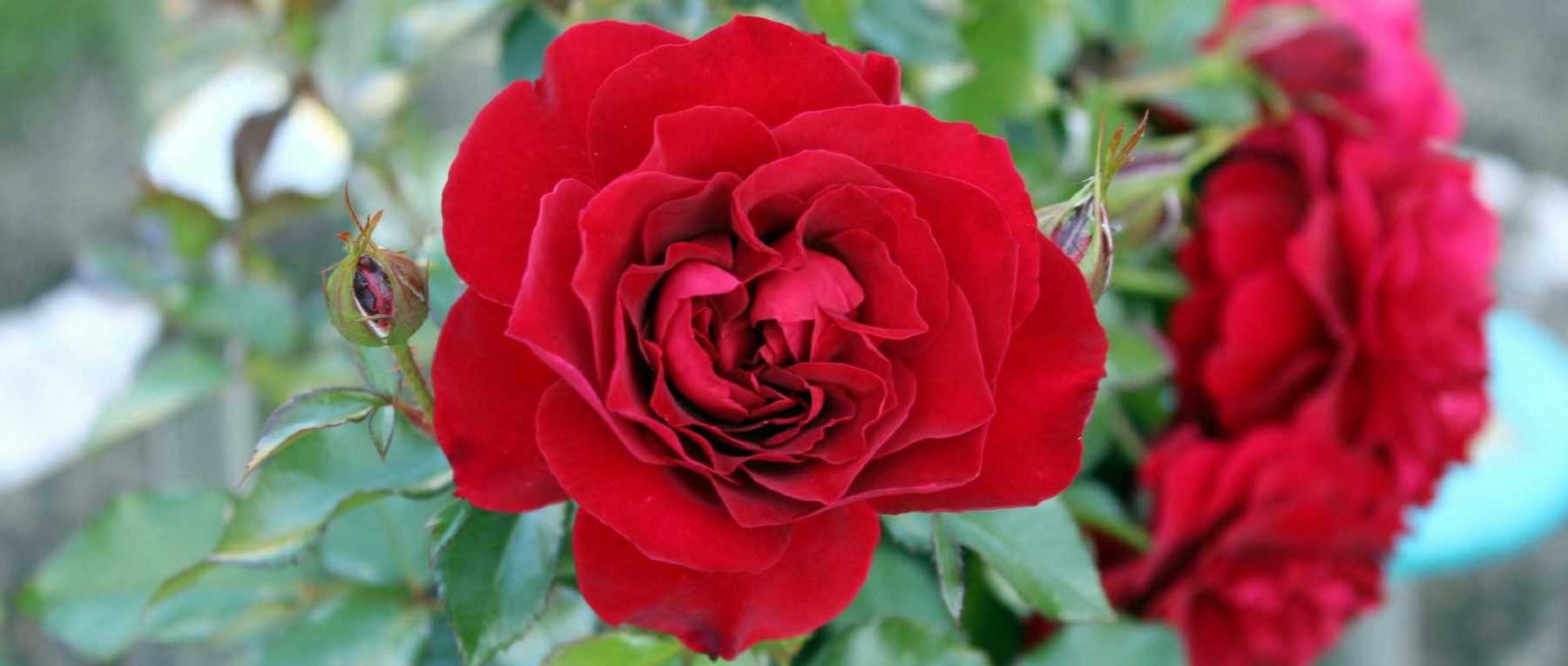
Roses: The Best Varieties and How to Grow Them
Contents
Roses in a nutshell
- Roses come in a wide variety of forms: they can be shrubby, climbing, ground-covering…
- They produce single or double flowers in an extensive colour palette!
- They’re cherished for their often delightfully fragrant blooms.
- They’re perfect for creating beautiful bouquets!
- The rose is an essential element for creating a romantic atmosphere in the garden! It also finds its place in English gardens.
Our Expert's Word
A true symbol of love and romance, with an extremely delicate bloom, the rose is the queen of flowers. It’s one of the most cultivated plants in gardens. We cherish it for its single or double flowers, often highly fragrant, and its superb divided foliage, deciduous or semi-evergreen. The flowers range from white to red, but can also be yellow, orange, or even mauve… There’s even an almost black rose with the ‘Black Baccara’ variety! Whatever their colour, roses always possess exceptional elegance, making them a key element in romantic gardens and English-style gardens.
With several thousand varieties, roses offer wonderful diversity! The most classic are bush and shrub roses, which fit easily into flower beds or borders, while other varieties grow as ground cover, and climbing roses scale pergolas or house facades. As for standard roses, they bring a very elegant touch to the garden and are perfect as standalone features, for example on a lawn.
Planting roses is possible year-round, but is preferably done in autumn in fresh, well-draining soil, rich in organic matter. The smallest varieties adapt well to container growing! Roses require some maintenance to ensure generous flowering. It’s advisable to fertilise them, water occasionally during dry spells, and prune them. They are susceptible to rust, powdery mildew, and black spot disease, and may require some treatments.
Botany
Botanical data
- Latin name Rosa sp.
- Family Rosaceae
- Common name Rose
- Flowering from June, and until autumn for repeat-flowering varieties
- Height highly variable, from 20-30 cm to over 10 metres
- Exposure sun or light shade
- Soil type rich and well-drained
- Hardiness -15 to -20°C
Roses are deciduous or semi-evergreen shrubs or climbing plants with thorny stems. There are approximately 150 species, native to Europe, Asia and North America. In France, there are slightly fewer than 20 wild species. Some originate from Asia but have naturalised, escaping from cultivated gardens (Rosa multiflora, Rosa rugosa, Rosa banksiae…). Rosa canina, the dog rose, is likely the most common wild species in France. The Gallic rose, Rosa gallica, is protected throughout metropolitan France.
Roses have been cultivated for over 5,000 years and have been extensively hybridised, to the point where there are now thousands of varieties, differing greatly in habit or flowering. Crossbreeding wild roses has led to a multitude of varieties… To navigate them, they are classified into different groups based on their characteristics, general form (climbing roses, bush roses…) or style (old roses, English roses…).
The rose gave its name to the Rosaceae family. This is a significant family, comprising around 3,000 species. It includes the most common fruit trees, such as plum, apple and cherry trees, as well as wild plants frequently found in France: hawthorn, bramble, rowan… And many ornamental plants: pyracantha, cotoneaster, cherry laurel, spirea, photinia, potentilla…
The height of roses varies extremely, from miniature roses measuring less than 50 cm tall to rambling roses that can climb several metres by scaling trees or walls. Thus, Rosa gigantea, the largest rose species, can reach over 20 metres in height by climbing other trees.
Roses can take on extremely varied forms! They are often bushy or shrubby, but many varieties are also climbing. They can be trained against a wall, over a pergola, an arbour, into a tree… The most vigorous climbing roses are called ramblers (e.g. Rosa banksiae). Others grow as ground cover, with a low, spreading habit. There are also miniature roses, well-suited to container growing, ideal for balconies or patios. Finally, some roses are grown as standards. They consist of a tall, straight stem topped with a ball of leaves and flowers. This form doesn’t occur naturally: it’s created by grafting a bush rose. The effect is less natural than other rose types but very elegant. When a rambling variety is grafted, these standard roses develop a weeping habit. We also distinguish landscape roses, which are quite low and grow very widely. Finally, some roses, like Rosa rugosa, are suckering! New stems emerge directly from the roots.
Rose stems can thus be upright, climbing or trailing. They usually bear thorns. These can be very decorative, as with Rosa sericea var. pteracantha, with its red, very broad thorns. Again, there are no strict rules – thorns vary in size, from very fine to quite broad, dense or more sparse. There are also thornless varieties.
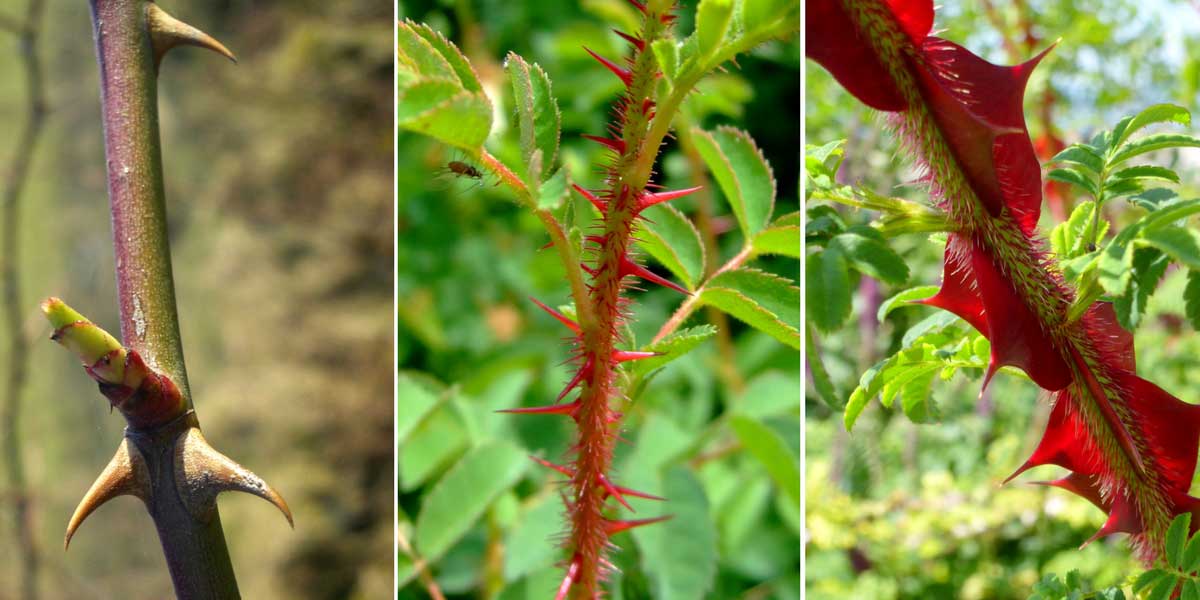

Rose thorns can take different forms! From left to right, Rosa canina, Rosa spinosissima and Rosa omeiensis ‘Pteracantha’ (photo Wendy Cutler)
Some roses flower only once, usually in late spring or early summer. This is often the case with old roses and climbing roses. Crossbreeding with Asian roses Rosa chinensis led to repeat-flowering varieties. Thus, modern roses often repeat flower, blooming from May-June until frosts.
Originally (in wild roses), flowers have five petals surrounding numerous stamens. It’s hybridisation and successive crosses that created double flowers with many more petals, sometimes up to sixty, as with the rose ‘La France’. These are actually modified stamens that have taken on petal form, often rendering the flowers sterile. Flowers can thus be single, semi-double, double or very double. They may be cup-shaped, pompon-like, globular or flat. Modern varieties (especially hybrid teas) are sometimes high-centred, giving them an extremely refined look.
Rose flower colours generally range from white to red, through subtle pink shades. But they can also be yellow or orange. The rose ‘Black Baccara’ is such a deep red it appears black. There are no truly blue varieties, but some approach it, like the mauve-blue flowers of ‘Mamy Blue’, or the violet blooms of ‘Rhapsody In Blue’. Pure white roses, like ‘Memoire’, are particularly elegant. Rose colours carry strong symbolism, with red varieties prized for their passionate intensity. Petals can also be bicoloured, as with ‘New Imagine’, ‘Betty Boop’ or ‘Abracadabra’! Some flowers show beautiful gradients, like ‘Little Sunset’, yellow at the centre then orange-pink at the edges. The rose ‘Blue Eyes’ offers a striking contrast with white petals marked purple at the centre.
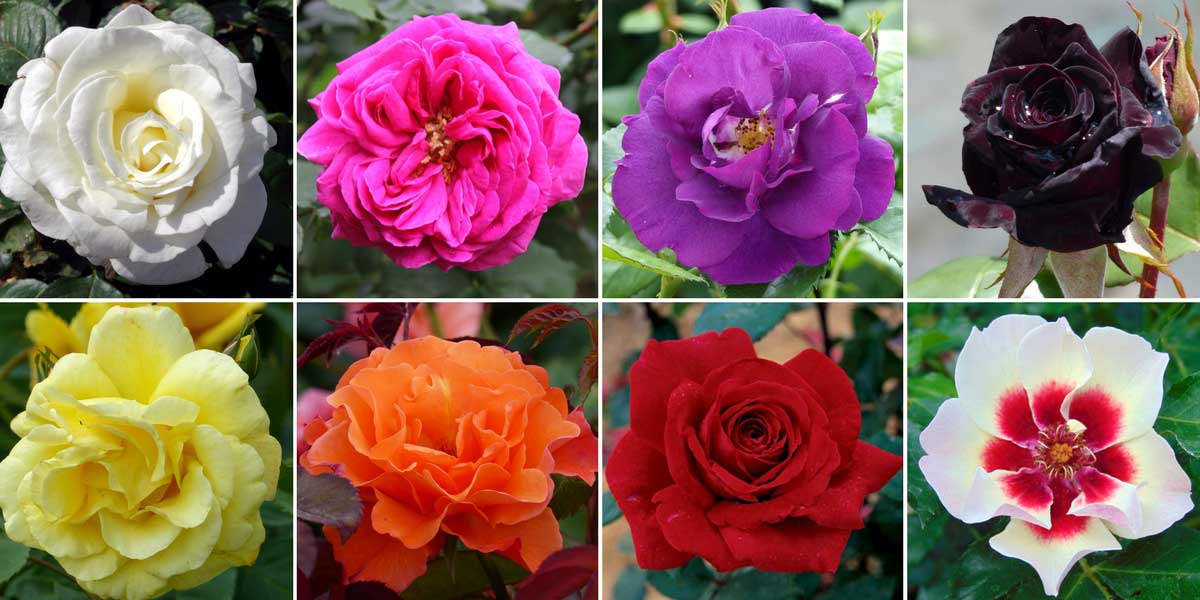

Roses offer very varied hues! From left to right and top to bottom, varieties ‘Memoire’ / ‘Madame Isaac Pereire’ (photo Rictor Norton & David Allen) / ‘Rhapsody In Blue’ / ‘Black Baccara’ / ‘Golden Gate’ / ‘Orange Climber’ / ‘Botero’ / ‘Coral Babylon Eyes’
Old roses are particularly prized for their fragrance! Modern varieties are often less scented, except for English roses. Scents can be musky, fruity, spicy, powerful or more subtle… The fragrance evolves through the day and varies with exposure. Discover also our most fragrant varieties!
Rose flowers can be solitary, as with hybrid tea roses. This showcases these often large, beautiful blooms individually. But roses can also bear flowers in clusters, as with multiflora, polyantha and floribunda roses.
Rose leaves are divided, usually composed of five to seven toothed leaflets. Some roses have up to nine leaflets, or more. They are arranged opposite each other with a terminal leaflet. Leaves can be very small: those of miniature roses measure up to 3 cm long, while larger varieties (like shrub or climbing roses) sometimes have leaves reaching 20 cm long. The leaf stalk base usually has stipules (small leaf-like structures at the leaf-stem junction).
Leaves are often green but can take on a glaucous, blue-grey hue, as with Rosa glauca. The rose Rosa ferruginea also has very glaucous, blue-grey leaves tinged purple. Young rose leaves sometimes develop attractive red tints!
Roses are most often deciduous, but can be evergreen, like the wild rose Rosa sempervirens. This has given rise to several semi-evergreen hybrids (‘Adélaïde d’Orléans’, ‘Félicité et Perpétue’, etc.).
In autumn, roses bear hips. These are spherical or oval, more or less elongated, and red, sometimes orange. They contain achenes, each enclosing a seed. These achenes have highly irritating hairs, earning them the name “itchy-backs”. Hips are edible, particularly rich in vitamin C, but the irritating hairs must be removed. They can make rose hip jam. Prioritise fruits of Rosa rugosa or dog rose (Rosa canina): these are the largest and most interesting for consumption.
This is the dog rose! It’s quite common in France. The flowers are pinkish-white, with five petals around numerous yellow stamens. These later form hips. This species is sometimes used as rootstock, particularly in chalky soil.
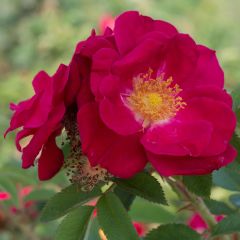
Rosa rugosa - Beach Rose
- Flowering time July to November
- Height at maturity 1,25 m
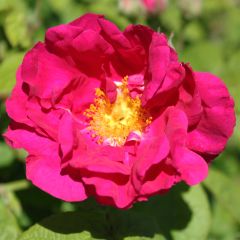
Rosa gallica Officinalis - Old Gallic Rose
- Flowering time July, August
- Height at maturity 90 cm
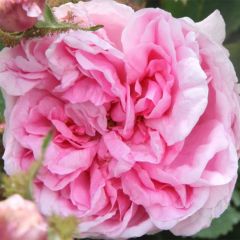
Rosa centifolia Muscosa - White Moss Rose
- Flowering time July, August
- Height at maturity 1,30 m
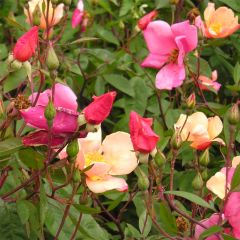
Rosa x chinensis 'Mutabilis' - China Rose
- Flowering time June to November
- Height at maturity 1,70 m
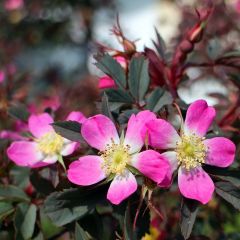
Rosa glauca Rubrifolia - Gallic Rose
- Flowering time July, August
- Height at maturity 2,50 m
The History of Rose Bushes
Roses have been cultivated for over 5,000 years in Asia, particularly in China. They were initially grown for their medicinal properties. These flowers were also cherished by the Egyptians and Romans.
The Damask Rose, Rosa damascena, was brought to Europe in the 13th century during the Crusades. At that time, in France, the cultivation of Gallic roses began, particularly Rosa gallica ‘Officinalis’, also known as the Rose of Provins or the Apothecary’s Rose, valued more for its medicinal than ornamental qualities. Through hybridization with other botanical species, Rosa gallica gave rise to the Cabbage Rose, Rosa centifolia, which later led to the development of Moss Roses. Old roses offered highly fragrant blooms but were not repeat-flowering.
In the 18th century, Chinese roses, Rosa chinensis, were imported, notable for their repeat-flowering trait. This allowed them to produce remontant hybrids, the Tea Roses.
In the 19th century, Empress Joséphine de Beauharnais developed a passion for roses and amassed an enormous collection at the Château de Malmaison.
From 1867 onwards, with Jean-Baptiste Guillot’s creation of the variety ‘La France’, the first Hybrid Tea rose, modern roses came into existence. Roses considered “old” are therefore all those bred before this date. This was followed by the development of cluster-flowered bush roses: Floribunda and Polyantha roses. Countless varieties were created by hybridisers such as Meilland or Georges Delbard. Later, English Roses emerged through the work of David Austin. Finally, Landscape Roses were developed—hardy, generous shrubs requiring minimal maintenance.
Discover other Roses
View all →Available in 1 sizes
Available in 1 sizes
Available in 1 sizes
Available in 1 sizes
Available in 1 sizes
Available in 1 sizes
Available in 1 sizes
Available in 3 sizes
Available in 1 sizes
Available in 1 sizes
The varieties
To ensure you have a hardy rose bush, prioritise those with the German ADR label. It evaluates both the flowering and the overall aesthetics of the plant, as well as disease resistance and adaptability to various climatic conditions. It guarantees a rose bush with good hardiness and the ability to thrive without chemical treatments.
These are hybrid tea roses: they are repeat-flowering varieties that form dense, branched bushes, shorter than shrub roses, and are suited to growing in beds or borders. The flowers are splendid—large, double, and often urn-shaped. They are perfect for bouquets!
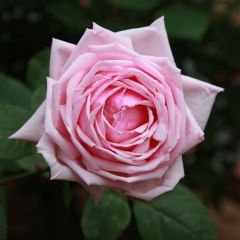
Rosa La France
- Flowering time July to December
- Height at maturity 1 m

Rosa 'Black Baccara' - Hybrid Tea Rose
- Flowering time July to October
- Height at maturity 90 cm
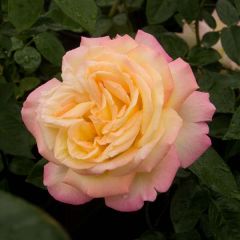
Rosa 'Madame A. Meilland' - Peace Rose - Hybrid Tea Rose
- Flowering time July to November
- Height at maturity 90 cm
Explore our wide range of large-flowered bush roses.
These are Polyantha and floribunda roses. They are repeat-flowering varieties that produce blooms in clusters of at least three and up to twenty flowers. Plant them in beds, borders, or hedges.
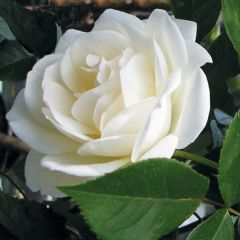
Rosa 'Fée des neiges' (Iceberg) - Shrub Rose
- Flowering time July to November
- Height at maturity 1,30 m
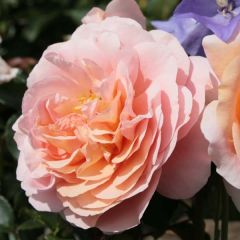
Rosa Garden of Roses
- Flowering time July to October
- Height at maturity 50 cm
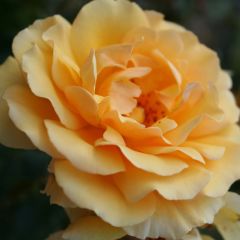
Rosa Amber Queen - Floribunda Rose
- Flowering time July to November
- Height at maturity 60 cm
Discover our cluster-flowered bush roses.
This group includes heritage varieties (musk and rugosa roses) as well as modern “landscape” roses. Shrub roses differ from bush roses in their greater height. Perfect for beds, they can also stand alone.
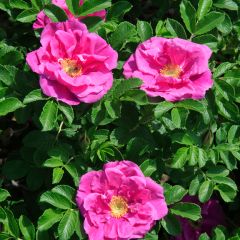
Rosa x rugosa 'Roseraie de l'Haÿ' - Rugosa Rose
- Flowering time June to November
- Height at maturity 2 m
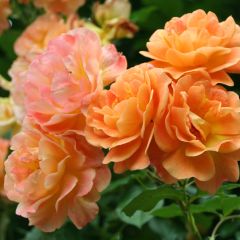
Rosa Westerland (Korwest) - Hybrid Shrub Rose
- Flowering time July to November
- Height at maturity 1,75 m

Rosa Nevada
- Flowering time July to September
- Height at maturity 1,50 m
Browse all our shrub roses!
Low-growing and spreading, these repeat-flowering varieties typically bear clustered blooms. Includes landscape roses—ideal for slopes or borders.
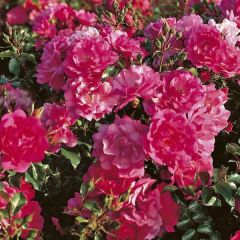
Rosa Decorosier Emera - Shrub rose
- Flowering time June to November
- Height at maturity 70 cm
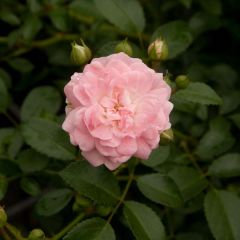
Rosa x polyantha The Fairy - Groundcover Rose
- Flowering time August to November
- Height at maturity 80 cm
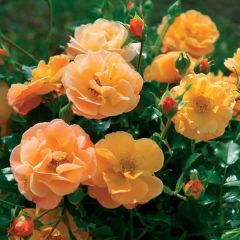
Rosa Decorosiers Calizia - Shrub Rose
- Flowering time June to November
- Height at maturity 70 cm
Explore our groundcover roses!
Under 50cm tall, these dwarf roses are perfect for pots on patios or balconies! Small leaves and abundant repeat blooms.
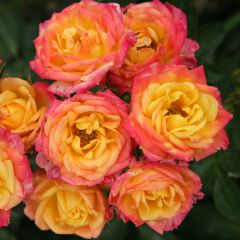
Rosa x polyantha - Lilliputs - 'Little Sunset' - Miniature Rose
- Flowering time June to October
- Height at maturity 40 cm
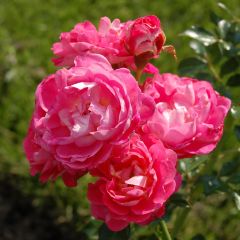
Rosa x polyantha 'Charmant' - Miniature Rose
- Flowering time June to October
- Height at maturity 40 cm
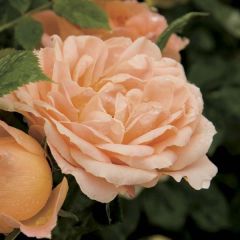
Rosa Sweet Dream
- Flowering time July to November
- Height at maturity 40 cm
Discover our range of dwarf and miniature roses in stock!
Long stems allow these varieties to cling to supports—perfect for walls, pergolas, or arbours.

Rosa Pierre de Ronsard - Climbing Rose
- Flowering time July to November
- Height at maturity 2 m

Rosa Ghislaine de Féligonde - Climbing Rose
- Flowering time July to November
- Height at maturity 3 m
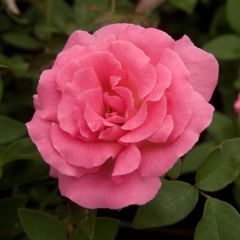
Rosa x Bourbon 'Zéphirine Drouhin' - Climbing Rose
- Flowering time July to November
- Height at maturity 3 m
Explore our beautiful climbing roses!
Exceptionally vigorous climbers—quickly cover facades or climb trees using their thorns. Profuse blooms (mostly non-recurrent).

Rosa banksiae 'Lutea' - Rambling Rose
- Flowering time May to July
- Height at maturity 12 m
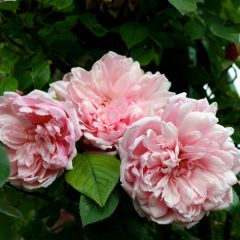
Rosa x wichuraiana 'Albertine' - Rambling Rose
- Flowering time June to August
- Height at maturity 6 m
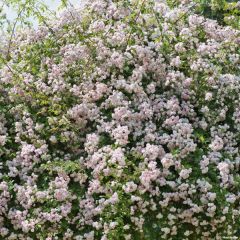
Rosa x moschata 'Paul's Himalayan Musk' - Rambling Rose
- Flowering time July, August
- Height at maturity 8 m
Browse our rambling roses!
Heritage roses may bear single or double flowers—often fragrant and delicate. Mostly non-recurrent.
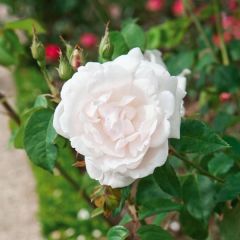
Rosa x Noisette 'Madame Alfred Carrière'
- Flowering time July to November
- Height at maturity 4 m
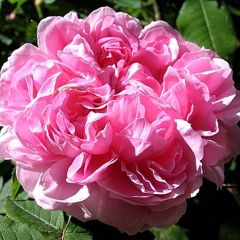
Rosa Jacques Cartier - Portland Rose
- Flowering time July to October
- Height at maturity 1,20 m

Rosa Ghislaine de Féligonde - Climbing Rose
- Flowering time July to November
- Height at maturity 3 m
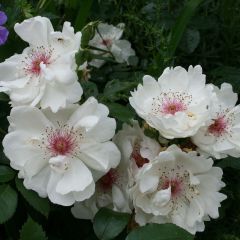
Rosa Jacqueline du Pré - Hybrid Tea
- Flowering time July to November
- Height at maturity 1,30 m
Our heritage roses are a must-see!
Shrub or climbing varieties with often fragrant double blooms. Repeat-flowering and prized for their delicate elegance—mostly David Austin cultivars.
→ Learn more in our guide How to choose an English rose
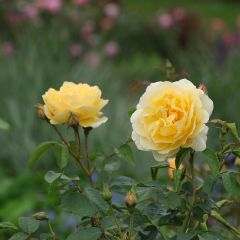
Rosa Graham Thomas - English Shrub Rose
- Flowering time July to November
- Height at maturity 1,50 m
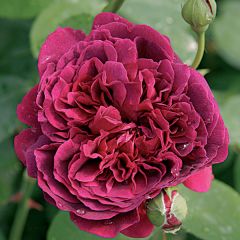
Rosa 'William Shakespeare 2000' - English Rose
- Flowering time July to November
- Height at maturity 1,25 m

Rosa Gertrude Jekyll - English Rose
- Flowering time June to November
- Height at maturity 1,20 m
Discover our range of English roses!
Read also
Taking Rose Cuttings: When and How?Planting
Where to plant?
Plant your roses in full sun or light shade. Sunlight ensures abundant flowering, although some varieties can tolerate shadier spots.
Roses are hungry plants that thrive in soil rich in organic matter. It’s best to add well-rotted manure or compost. Your rose will flourish in deep, well-draining soil. Excess moisture should drain away to prevent fungal diseases. If your soil is heavy or clay-based, improve drainage. Avoid overly chalky soils too, as they may cause chlorosis (yellowing leaves), unless the rootstock is Rosa canina, which tolerates chalk well.
Choose a sheltered yet open spot, avoiding cramped positions (e.g., squeezed against a wall or other plants). Good air circulation helps prevent disease. Similarly, don’t plant roses where roses previously grew, to reduce fungal disease risks.
When to plant?
The best time to plant bare-root roses is autumn. However, if your soil is heavy or clay-based, wait until late winter. Bare-root roses can be planted from late autumn to early spring (November to March), while container-grown roses can be planted year-round. Avoid frosty or extremely hot periods.
→ Also read: When to plant roses?
How to plant?
- Start by pruning branches to about 30cm. Trim the roots slightly too.
- Soak the rootball in water to rehydrate it and encourage establishment.
- Dig a generous hole, ideally around 50cm deep. Add well-rotted compost or manure, as roses love organic-rich soil. For heavy clay soil, improve drainage with gravel or pumice.
- Gently tease out the roots.
- Place the rootball in the planting hole. Position the graft union slightly above soil level—traditionally, it’s advised not to bury it, especially in unsuitable soils (e.g., chalky). However, burying it slightly can protect the graft in harsh climates.
- Backfill and firm the soil. Create a watering basin.
- Water thoroughly.
Keep watering regularly during the first year. Mulch or plant ground cover around the base to suppress weeds and retain moisture.
Some roses, especially dwarf varieties, thrive in pots! Learn more in our guide: Growing roses in pots
For more tips, explore our rose planting guide! Also read: Bare-root roses in rootballs: the ideal compromise and How to plant a climbing rose?
For a full illustrated guide, see: “Roses: how to plant in pots or bare-root”
Maintenance and Pruning
Roses are delicate plants that require some maintenance. We recommend regularly removing faded flowers to avoid unnecessarily exhausting the plant, unless you wish to obtain rose hips. Besides the aesthetic benefit, removing these spent blooms will encourage the emergence of new flowers.
Roses are hungry plants. We advise applying fertiliser in early spring, before flowering. Give a second application in June-July. Choose one particularly rich in potassium and, if possible, magnesium. You can also use organic amendments such as crushed horn or dried blood…
Roses require watering mainly during dry periods. At other times, they can manage without. Water at the base of the shrub, avoiding wetting the foliage, which could promote disease development. Water regularly during the first year after planting. Watering needs to be much more frequent if you grow your rose in a container rather than in the ground. By adding a layer of mulch around your rose, you can significantly reduce watering and weeding. Choose materials like dead leaves or wood chips (BRF), but avoid pine bark.
Roses are susceptible to powdery mildew, rust and black spot. Powdery mildew is identified by a white, powdery coating on leaves, while rust appears as small orange-brown pustules on foliage. Black spot, caused by the fungus Marssonina, is characterised by brown spots on leaves which then yellow and discolour. Against these diseases, you can use nettle manure, horsetail decoctions or fungicide. Roses are also frequently attacked by aphids.
Having trouble with your rose? Discover our advice sheets: “Rose diseases – identification and treatments” and “Roses: aphids and other pests”, Help! Spots on my roses!; How to rejuvenate an old climbing rose?
And our podcast:
→ Learn more about plant galls, which can affect roses.
Roses are usually grafted, and they can produce suckers – vigorous stems that grow rapidly from below the graft union. These should be removed by cutting them off at the base.
To maintain a harmonious shape and ensure abundant flowering, roses need regular pruning.
Consult our advice sheets and video tutorials on the subject:
Propagation
Sowing
Sowing roses is fairly straightforward. Sowing seeds from cultivated varieties may give unpredictable results in terms of flower colours and shapes, but you can try hybridising your varieties this way! Sowing botanical species will yield more reliable results. Sowing species can also produce plants that will serve as rootstocks.
- Collect rose hips, then dry them before extracting the seeds. Rose seeds require a cold period to break dormancy (vernalisation). To do this, mix the seeds with sand and place them in the refrigerator for one to two months.
- Remove the seeds.
- Fill a pot with a mix of compost and sand. Firm down and water to moisten the substrate.
- Sow the seeds.
- Cover them with a thin layer of sand.
- Place the pot in a cool, shaded spot.
Grafting
Most commercially available roses are grafted. You can graft your roses using the budding technique. Preferably use Rosa multiflora or Rosa laxa as rootstock, unless your soil is chalky: in this case, you should choose Rosa canina (dog rose).
Carry out the procedure in summer, around August. Select and cut a healthy shoot from the variety you wish to propagate. Prepare it by removing leaves and thorns but leave the petioles in place. Carefully remove a bud with its petiole by making a delicate incision in the bark. If there is wood beneath the bud, you must remove it. Then, on the rootstock, near the crown, make a T-shaped incision to open the bark without cutting into the wood (you will feel resistance when reaching the wood). Insert the bud, and if it protrudes slightly, trim the edges. Then bind the graft point, leaving the grafted bud visible.
→ Learn more in our guide How to graft roses: the budding technique.
Taking Cuttings
Roses are best propagated from cuttings in late summer, using semi-hardwood shoots.
For more information, check out our guide on taking rose cuttings, and Olivier’s video: When and how to take rose cuttings? Also discover the film La fine fleur which explores rose hybridisation.
Association
Roses are undoubtedly the essential element for a romantic garden! Their fragrant blooms bring charm and delicacy to the garden. You can pair them with the delicate flowering of Weigelias and Deutzias. Also enjoy the airy white blooms of gypsophila, Crambe cordifolia, or Gillenias.
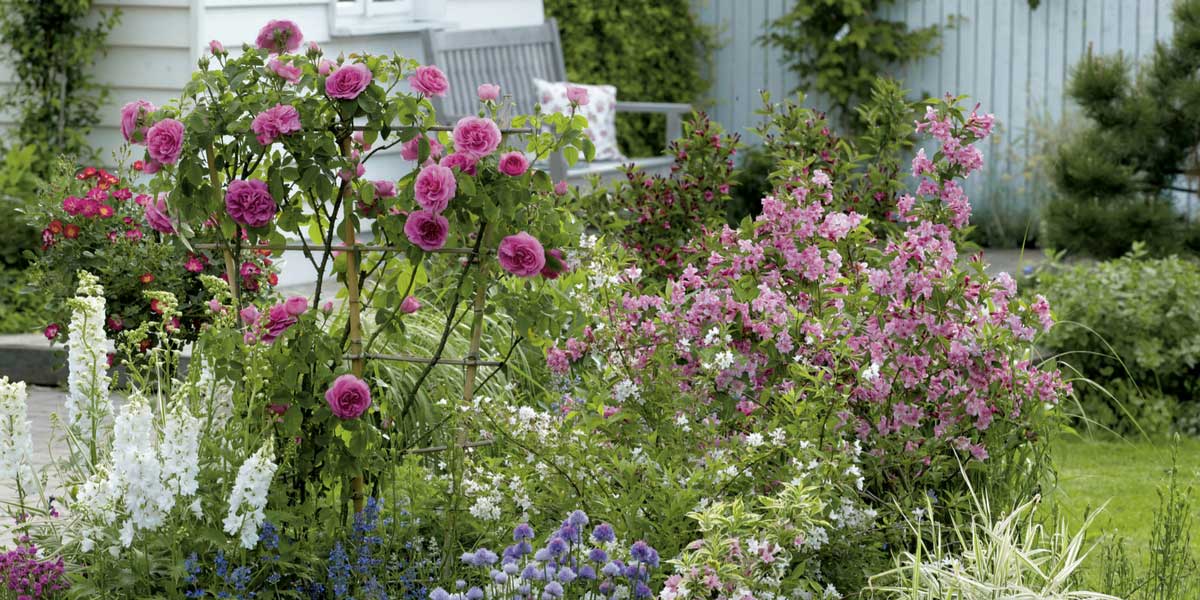

For a romantic border, combine blooms in gentle hues: Rose ‘Gertrude Jekyll’, Weigelia florida ‘Nana Variegata’, Deutzia gracilis and Delphinium (Photo: Friedrich Strauss – Biosphoto)
Don’t hesitate to plant perennials or ground cover at the base of your roses, they make stunning pairings. This will help cover their sometimes bare stems, suppress weeds… And, depending on the plant chosen, add colour even when the rose is not in bloom. You can choose lady’s mantle, hardy geraniums, or heucheras.
Roses come in a wide range of shades… take advantage of this to play with colours! You can create a beautiful orange scene by pairing the rose ‘Grace’ with heuchera ‘Marmalade’. You can also surround your roses with darker plants to highlight their luminous blooms. If you pair them with other soft hues, you’ll create a border full of gentleness. Generally, roses pair beautifully with blue-flowered spiked plants like lavenders, catmints or sages, but also with delphiniums, aconites or bellflowers. A deep, intense blue can create a stunning contrast!
Pair deep red roses with the pure white blooms of astilbes or Gillenia! As a general rule, we recommend pairing your roses mainly with other pastel-toned plants: soft pink, white, mauve, blue. Also take advantage of silver-leaved plants: the softness of Stachys byzantina, or the finely cut foliage of Artemisia.


Play with colours by creating harmonies or contrasts! Rose ‘Grace’ and Heuchera ‘Marmalade’ (Photo: Howard Rice – GAP Photos) / Rose ‘Sir John Betjaman’ and Gillenia trifoliata (Photo: Nicola Stocken – GAP Photos) / Rose ‘The Fairy’ and Gypsophila rosenschleier (Photo: Pernilla Bergdahl – GAP Photos)
Clematis are perfect companions for roses! They come in a wide range of colours and forms. You can train a climbing rose and a clematis side by side on a wall or pergola.
Roses can also be part of a wild and natural garden! Choose botanical roses, or at least varieties with single blooms, such as Rosa chinensis ‘Mutabilis’… And pair them with airy blooms: gypsophila, alliums, asters, love-in-a-mist, Mexican fleabane, even poppies and cosmos… Don’t hesitate to add some ornamental grasses: fountain grass, feather grass or reed grass. You can also enjoy the delicate blooms of masterworts, foxgloves or squills.
→ Also read Ornamental Grasses and Roses: A Winning Combination and Gardening Naturally with Botanical and Wild Roses
Need more ideas? Follow Olivier as he presents beautiful pairings in this video:
Did you know?
- Rosehip Jam
You can make jam from the rosehips that rose bushes produce in autumn. These berries are very rich in vitamin C and boost the immune system. Preferably use those from the dog rose, Rosa canina, or from Rosa rugosa. They are commonly called “itchy-backs” due to the irritating hairs inside the berries. These must be removed, along with the seeds, to consume only the pulp and skin.
- Versatile Uses!
Beyond rosehip jam, roses are widely used in cosmetics and perfumery.
Rose petals are edible. You can add them to salads. When dried, they can be used in potpourri, as decoration, or for infusions. Rose water (or hydrosol, obtained from Rosa damascena or Rosa centifolia) is renowned for its many benefits for the skin. Damask rose is also used in essential oil form. Of course, roses are also irreplaceable in bouquets or as decoration with petals, for example at weddings. Finally, depending on the country and region of the world, rosehips are used to make decoctions, ice cream, juice, beer, or liqueur…
- Record Longevity
In Germany, the Rose of Hildesheim is considered the oldest in the world. Legends say it could be over a thousand years old. Its exact age is uncertain, but it is confirmed to be at least 400 years old. It survived the bombings of 1945: the rose and the cathedral it grows against were damaged, but shoots regrew from beneath the ruins.
- Rose Gardens to Visit!
France boasts some beautiful rose collections. For instance, the Val de Marne Rose Garden in L’Haÿ-les-Roses, near Paris, is a stunning modern rose garden featuring over 3,000 varieties. The three rose gardens in Lyon’s Parc de la Tête d’Or are also worth a visit! And in Germany, the Sangerhausen Rose Garden holds the world’s largest rose collection, with over 8,000 varieties.
- Curiosities – Unique and Unusual Roses!
Roses offer such diversity that there are several surprising or peculiar varieties! For example, Rosa chinensis ‘Viridiflora’ has green flowers, as they are composed not of petals but of numerous elongated bracts, sometimes marked with red. Similarly, while the vast majority of wild roses—and even Rosaceae—have five petals and sepals, Rosa sericea is a surprising rose with four petals and four sepals. As for Rosa omeiensis ‘Pteracantha’, its stems bear very large, translucent red thorns. There are also moss roses, whose flower buds are covered in a kind of “moss” made up of epidermal outgrowths. Finally, the ‘Fraise des Bois’ rose bears flower buds that never open! The size, red colour, and conical shape of its buds resemble small strawberries.
Useful resources
- Our video advice: How to plant a bare-root rose bush?, How to prune old roses?, Pruning modern roses, When and how to take rose cuttings?, Rambling roses;
- Discover our advice sheets on growing and caring for roses: Roses – How to plant them, Taking rose cuttings – When and how, Pruning roses and When to prune roses?, Rose fertilisers, Help, spots on my roses!, When and how to prune a standard or weeping rose?, Why are roses grafted?, What is a rootstock and which one to choose?; Plant galls: what are they?, Planting roses in very cold climates, How to remove an old rose bush?, How to rejuvenate an old climbing rose?; 8 misconceptions about roses, Help: my rose is suffering from drought; Our secrets for thriving potted roses!; The best mulches for roses: choosing and applying the right mulch; Rose suckers: why and how to remove them?
- Discover all our tips for successfully growing climbing roses in pots, Rosa banksiae: How to grow it successfully and Rosa banksiae: discover these exuberant rambling roses!
- Discover our advice on roses by use or location: 8 perfect roses for pots, 10 roses for pergolas, Choosing a climbing rose, How to choose a rambling rose?, Rose hedges: the 10 best varieties, How to choose a groundcover rose?, The best roses for Mediterranean climates, How to choose an English rose?, 10 summer-flowering shrubs you must have in your garden, 5 climbing plants that won’t damage walls, 7 roses for shady gardens, 7 climbing roses with exceptional fragrance, 6 white-flowered groundcover roses; the 9 most beautiful old roses; 5 yellow-flowered climbing roses; 6 yellow-flowered groundcover roses, What to plant at the base of roses?, Which roses for a slope?; Which rose to adorn an arch?; Roses: the best varieties for dry soil; 5 roses for edging a path
- Advice sheets on great names in roses: The most beautiful Kordes roses, The most beautiful Delbard roses, The most beautiful Meilland roses, the most beautiful Guillot roses
- Our landscaping advice around roses: How to create a rose garden? and 6 tips for creating a beautiful rose bed, 7 planting ideas for beautiful summer containers, Add originality to your garden with these 7 unusual roses; Garden naturally with botanical and wild roses
- Our gourmet and fragrant advice sheets about roses: Cooking with roses, Rose petal jam recipe and the fragrance of roses, 10 tips for creating beautiful rose bouquets, 10 fragrant pink-flowered roses, 6 highly fragrant white roses, 7 climbing roses with exceptional fragrance, 9 highly fragrant red roses; 7 fragrant yellow roses;
Frequently asked questions
-
The leaves on my rose bush are turning yellow. What should I do?
This is likely iron chlorosis. The foliage discolours between the veins because the rose bush lacks iron and other minerals necessary for proper photosynthesis. We recommend applying iron chelate and regularly feeding your rose bush with fertiliser. This could also be caused by black spot disease, which results in yellowed, discoloured areas around brown spots on the leaves.
-
The leaves of my rose bush are covered in a white powdery coating! What should I do?
Your rose bush is affected by powdery mildew, a fungal disease favoured by a combination of heat and humidity. To prevent its spread, we recommend removing and burning the affected leaves. You can spray with baking soda or a horsetail decoction.
-
The leaves of my rose bush have small orange pustules!
It's rust, a disease caused by a fungus. Here again, we advise you to cut off and burn the affected parts. Treat with a horsetail decoction.
-
The leaves of my rose bush have black spots!
This is a disease caused by the fungus Marsonia. It is one of the three most common diseases affecting rose bushes. Use a horsetail decoction to get rid of it.
- Subscribe!
- Contents


































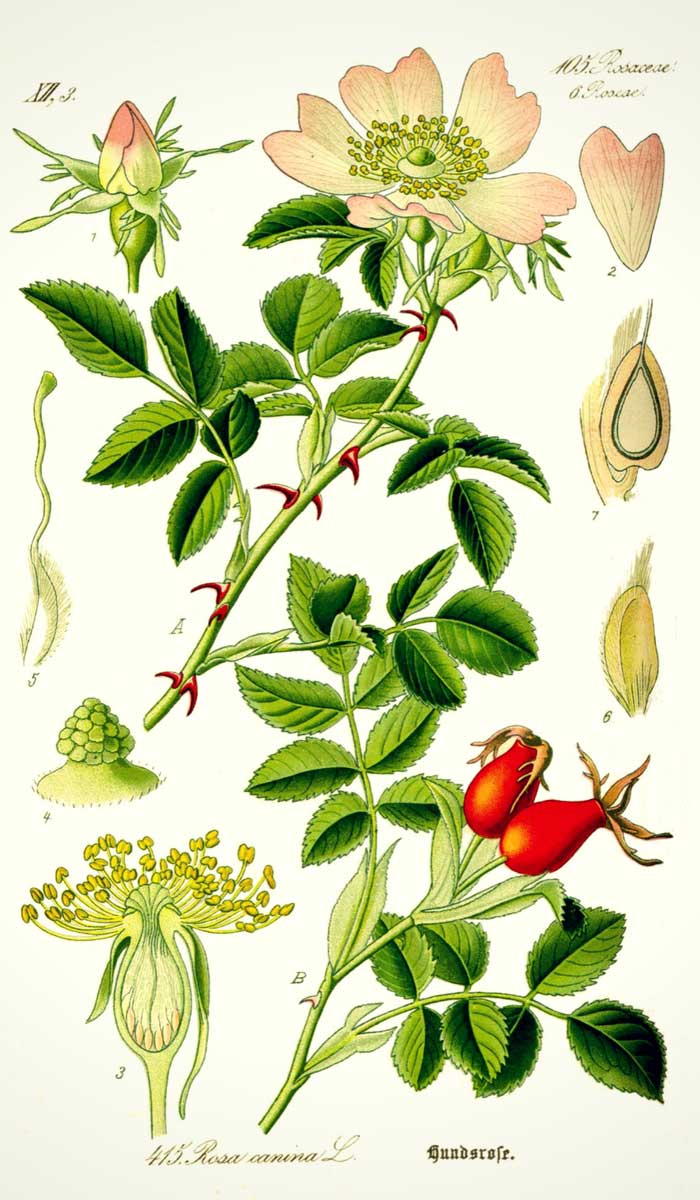
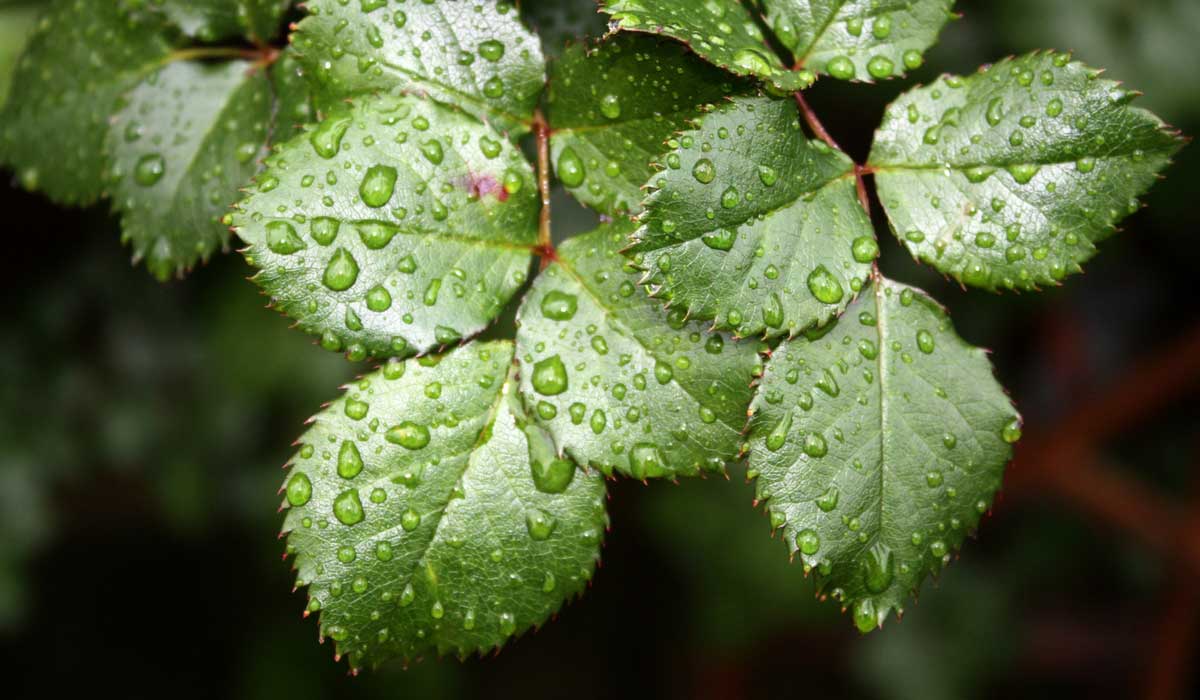
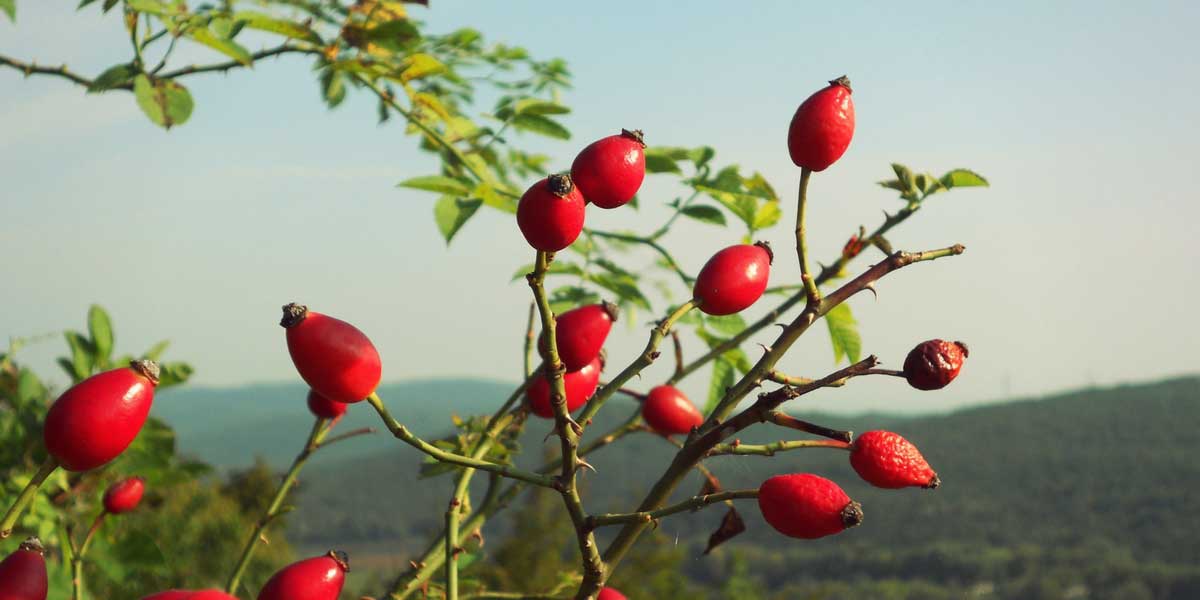
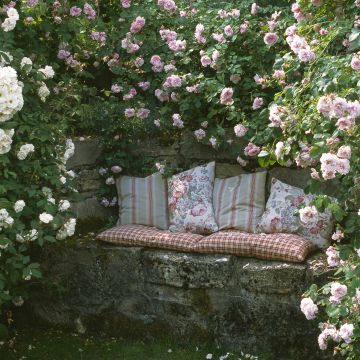
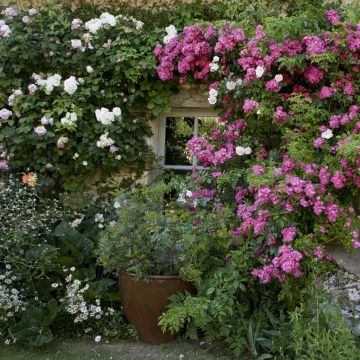
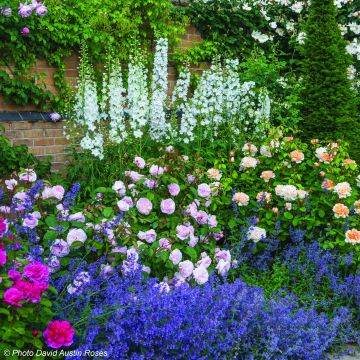
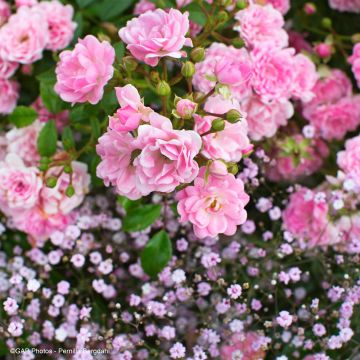
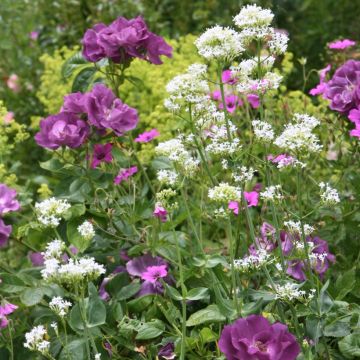
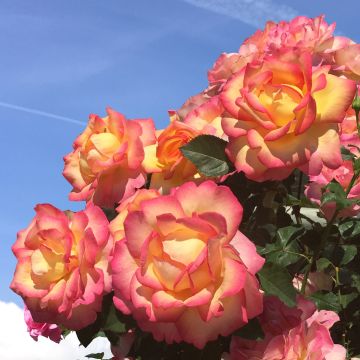


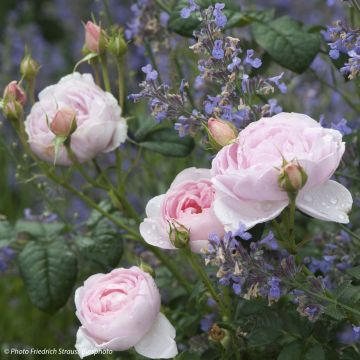
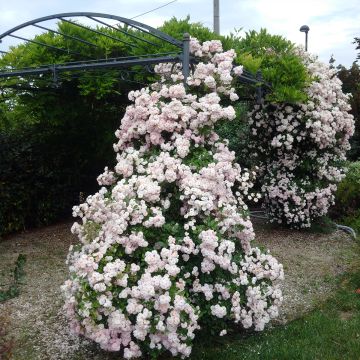
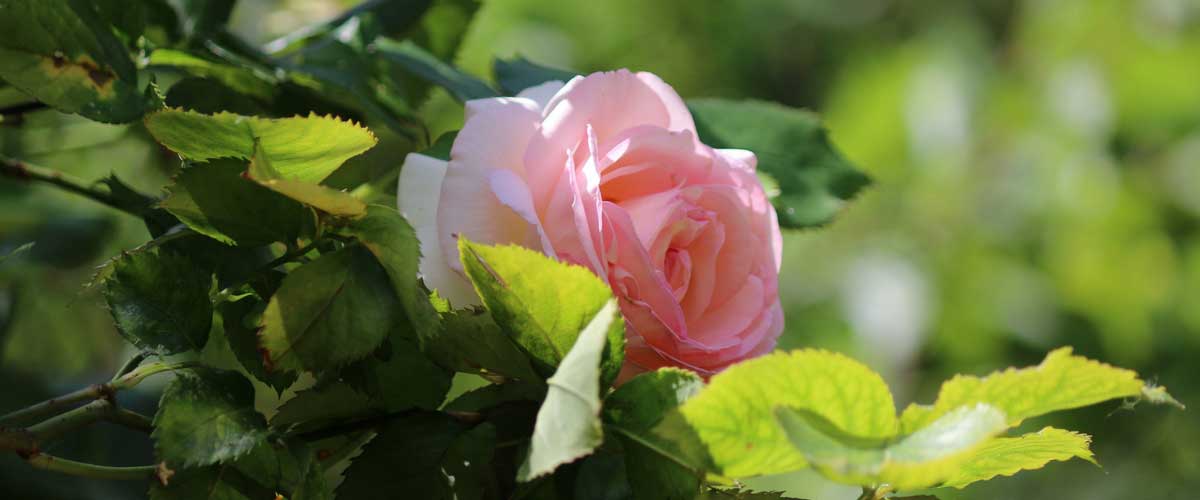
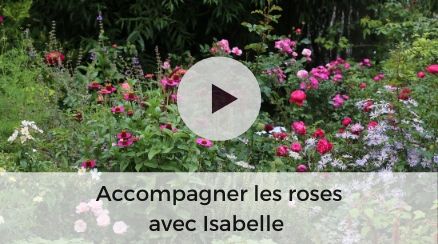

Comments